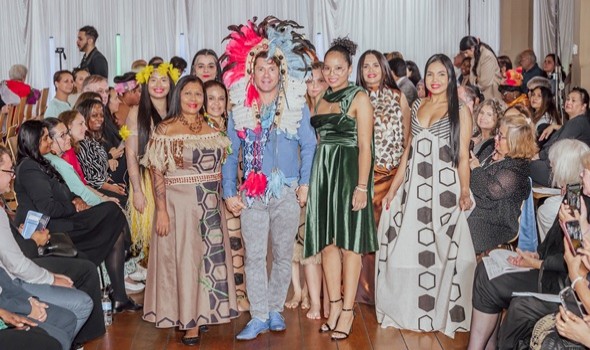Heritage on the catwalk
Heritage on the catwalk

“We Wear Heritage” is a fashion show with a difference that brought a new dimension to the most recent London Fashion Week by highlighting traditional garments from some of the hundreds of communities who enrich British life.
The 11 communities identified themselves as or coming from: Brazil, Afghanistan, China, Goan Indian, Caribbean, Iraq, Africa, Romania, Somalia, Tamils and Dominica.
All are based in the London borough of Brent and are researching unique aspects of traditional textiles, clothing, or costumes.
The show was organised by Rafael dos Santos, director and CEO of Best of Brazil Community. Brent is home to about 35,000 Brazilians.
The research groups include:
Afghan Association of London
Afghanistan’s traditional womenswear is often adorned with handmade embroidery on the body and sleeves. The combination of vibrant colours, made famous during the 1960s, highlights the creative expression and know-how of garment makers.
African
The aim is to preserve the heritage of African fabric, by engaging young people and the wider community. Project aims to explore the vibrant history, artistry, and cultural significance of African fabric.
Best of Brazil Community
The fabrics are natural materials found in the Amazon. They include bark trees, palm leaves, paint from jenipapo fruit, and fish scales. The Mundurucu tribe wears these outfits.
Brent Chinese Association
Clothing worn by the diasporic Chinese communities, such as the Cheongsam and Hanfu for women and the Tang suit for men. Worn for special occasions.
Higher Potential
Clothing from the 1970s/80s when rap, hip-hop, reggae, and soul-funk influenced a generation. Caribbean young people wore Beaver Hats, tailored and tonic suits, creating trends that contributed to wider youth culture.
WOB Dwiyet, Dominica
Caribbean creole style is rooted in a blend of English, French and African traditions created by 18th century women of colour. Madras fabric plays a significant role in heritage wear, teamed with broderie anglaise and ribbons. The Wob Dwiyet, an elegant gown created and still worn today as a symbol of stature, popular in the French creole speaking islands; the Jip outfit is a less formal alternative.
Goan Traditional Clothing
Traditional attire blends indigenous traditions and Portuguese colonial influence. The project connects the costumes worn with specific cultural events of significance within the Goan community. Some Goan costumes relate to specific music and dance performances.
Iraqi Welfare Association
Folklore clothing and costumes represent the area’s ancient cultures and beliefs and facilitate a bridge of communication between different communities around the world. The organisation plans to organise heritage festivals to bring diverse communities together.
My Romania Community
The project examines Romanian garments' unique characteristics and cultural significance, highlighting craftsmanship and symbolism. There’s also a royal UK-Romania connection through Queen Marie of Romania.
Hido iyo Dhaqan
Focusing is on the intricate beauty of Hido iyo Dhaqan wear, which embodies the essence of Somali culture, reflecting its history, values, and identity through its textiles and designs.
The Tamil Association of Brent
The association is creating records of traditional clothing through photography and video. Oral histories are collected from Tamil elders and dubbed and subtitled in English. The transcriptions will be used to produce an electronic book. The project will also film a Tamil wedding showing how rituals have changed over the years.
.png)


